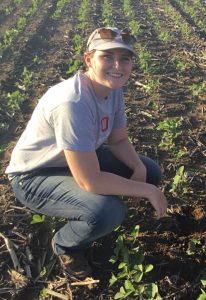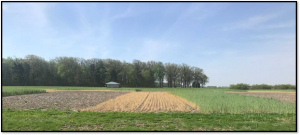Continuous soybeans and cover crops
By Dusty Sonnenberg, CCA, Ohio Field Leader
Soybean growers across Ohio, and especially farmers enrolling in the new H2Ohio program, will be interested in research conducted by Keeley Overmyer, investigating possible impacts from a crop rotation with continuous soybeans and the use of cover crops. Overmyer’s research was funded by a grant from the Ohio Soybean Council and Soybean Checkoff.
According to a survey conducted by the North Central Soybean Research Program, there has been a steady increase in the percentage of Ohio fields with soybeans following soybeans. In 2014, only 8% of the soybean fields were in a continuous soybean system. Just 4 years later, that number has climbed to 17% of the fields in Ohio with soybeans following soybeans. According to the 2017 Census of Agriculture, 718,000 acres of cover crops were planted in Ohio. Percentages have continuously climbed with soybean fields having a cover crop planted either prior to the soybean crop, or following the soybeans.
For the past two years, Overmyer has investigated the impact of cover crops in a continuous soybean system on disease,

insects and yield. This study was conducted at the Ohio Agricultural Research and Development Center research farms near South Charleston and Hoytville. The plots were continuous no-till soybeans. The cover crop mixture was planted at four different planting dates in the fall, based on when the soybeans were harvested. For the study, Overmyer used a 50-50 cover crop mixture of oats and cereal rye at 50 pounds per acre. To terminate the cover crops, the oats winterkilled, and the rye was killed in the spring with a glyphosate and Select spray mix. For the study, the rye cover crop was terminated before the soybeans were planted at either an early date of 14 days prior to planting or a late date of 7 days prior to planting of the beans. All the soybeans were planted on the same date.
Overmyer set out to answer the question, “Do cover crops in continuous soybean systems impact disease and insect pressure, and yield?” She evaluated the effect of cover crop planting date and termination date on: seedling disease causing pathogens (Pythium, Phytophthora, Rhizoctonia, and Fusarium), stand counts, soybean cyst nematode, slug pressure, insect populations/diversity, insect defoliation, foliar disease, insect pod damage, and yield.
Each year was analyzed separately due to large differences in the weather and growing conditions. In 2018, there was a significant impact on soybean stand at the South Charleston location.
“As the amount of rye cover crop increased, the soybean stand was positively impacted,” Overmyer said. “Especially in the control plot without any cover crop, there was an almost 50% soybean stand reduction.”
Overmyer surmises that the reason may be due to ponding of water in the plots caused by heavy rain events, and where the cover crops helped utilize some of the excess water, whereas the control plot remained wet with nothing to take-up any excess water.
“That is most likely why the stand reduction occurred,” Overmyer said. “Similar findings did not occur at the Hoytville location in 2018 as the weather was different. The same stand loss was not experienced in 2019 at either location.”
In 2018 at the South Charleston location there was a 4 to 6 bushel per acre yield advantage in the plots with a cover crop over the control plots without a cover crop. The greatest advantage occurred in the plots with the earlier cover crop planting dates in the fall, and the early termination date in the spring.
“There was also a similar yield impact in 2018 at the Hoytville location, however it was only a 2 bushel per acre yield advantage in the cover crop plots over the control,” Overmyer said. “In 2019 there was an average yield advantage of 2 bushels per acre in the plots with cover crops versus the control. The greatest yield advantage was found in the plots where the cover crop was planted at the earlier date in the fall, and terminated on the early date in the spring. All the plots with biomass from a cover crop yielded better than the control with no cover crop biomass, however those with the early planting and early termination consistently yielded the best.”
There was no impact measured in disease or insect pressure.
“The presence or absence of the cover crop did not induce disease and insects, and it did not reduce them,” Overmyer said. “This is helpful to know so farmers do not need to be concerned about creating a habitat harmful to the soybeans from a disease and insect pressure standpoint if they plant a cover crop.”
Soil samples were measured for SCN in the fall prior to the cover crop being planted, once the cover crop was terminated, and again at soybean harvest. No SCN impact was noticed.
While not a specific parameter measured for this project, a significant amount of weed pressure was noticed in the spring in the control plots according to Overmyer.
“In the plots with no cover crop at all, there was a lot of weed pressure, especially at the Hoytville location. Common ragweed, Pennsylvania smart weed, and giant foxtail were most noticeable in the control plots,” Overmyer said.
All the plots were sprayed with herbicide at the time of cover crop termination, including the control plot.
“With the overall yield advantage across both locations and years only being an average of 2 bushels per acre, when cover crops were used, the economics will not necessarily convince a farmer to add this practice to their soybean rotation, however if a farmer is already using cover crops, they should be confident that they are not going to see a yield reduction,” Overmyer said. “I had hoped that there would be a rotational benefit to incorporating cover crops into a continuous soybean rotation, but that was not the case during the two years of the study.
“If a farmer is considering adding cover crops to their rotation, there are some recommendations to consider. Farmers should prioritize and focus on planting cover crops early in the fall and terminating them early (10 to 14 days before planting) in the spring to maximize the yield benefit. Cover crops are an investment, and if you are going to invest your time and money in a cover crop, then you should prioritize them to gain the most benefit.”
Cover crop biomass did improve the soybean stand compared to planting into bare ground. “Farmers need to figure out what amount of biomass they are comfortable planting into with their equipment and plan accordingly to determine a termination date, aiming for 10 to 14 days prior to the planting date,” Overmyer said. “Given the weather patterns Ohio has been experiencing in the spring, this may be a notable benefit.”